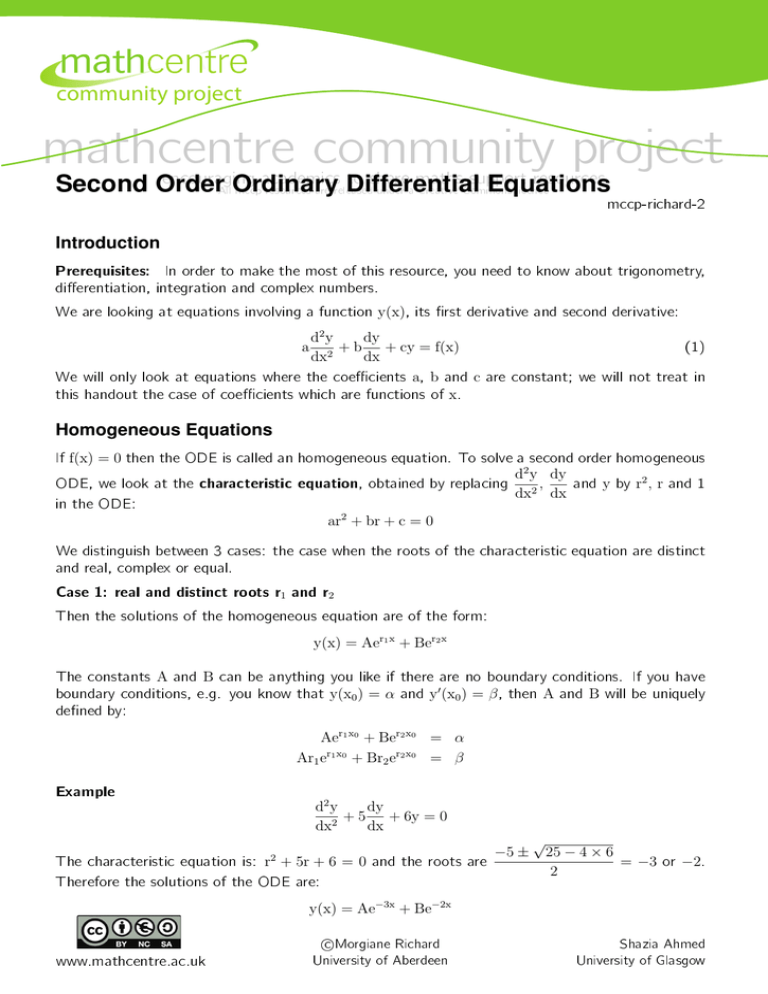mathcentre community project Second Order Ordinary Differential Equations community project
advertisement

community project mathcentre community project encouraging academics Differential to share maths support resources Second Order Equations All Ordinary mccp resources are released under a Creative Commons licence mccp-richard-2 Introduction Prerequisites: In order to make the most of this resource, you need to know about trigonometry, dierentiation, integration and complex numbers. We are looking at equations involving a function y(x), its rst derivative and second derivative: d2 y dy + b + cy = f(x) 2 dx dx We will only look at equations where the coecients a, b and c this handout the case of coecients which are functions of x. (1) a are constant; we will not treat in Homogeneous Equations If f(x) = 0 then the ODE is called an homogeneous equation. To solve a second order homogeneous d2 y dy and y by r2 , r and 1 ODE, we look at the characteristic equation, obtained by replacing 2 , dx dx in the ODE: ar2 + br + c = 0 We distinguish between 3 cases: the case when the roots of the characteristic equation are distinct and real, complex or equal. Case 1: real and distinct roots r and r 1 2 Then the solutions of the homogeneous equation are of the form: y(x) = Aer1 x + Ber2 x The constants A and B can be anything you like if there are no boundary conditions. If you have boundary conditions, e.g. you know that y(x0 ) = α and y0 (x0 ) = β , then A and B will be uniquely dened by: Aer1 x0 + Ber2 x0 = α Ar1 er1 x0 + Br2 er2 x0 = β Example d2 y dy + 5 + 6y = 0 2 dx dx The characteristic equation is: r + 5r + 6 = 0 and the roots are Therefore the solutions of the ODE are: 2 −5 ± √ 25 − 4 × 6 = −3 2 or −2. y(x) = Ae−3x + Be−2x www.mathcentre.ac.uk c Morgiane Richard University of Aberdeen Shazia Ahmed University of Glasgow Case 2: complex roots If the roots are complex then they can be written as r + js and r − js (with j the imaginary number, j2 = −1) and the solutions of the homogeneous equations are of the form: y(x) = erx Aejsx + Be−jsx written as = erx (Ccos(sx) + Dsin(sx)) mathcentre community project which can also be encouraging to maths support resources As before, the constants A mccp andacademics B (or Careand D)share will denedCommons by the licence boundary conditions. All resources released underbea Creative Example d2 y dy + 4 + 9y = 0 2 dx dx The characteristic equation is: r + 4r + 9 = 0 and the roots are √ −2 − 5j. Therefore the solutions of the ODE are: 2 −2x or = e−2x y(x) = e √ 5xj −4 ± √ √ 16 − 4 × 9 = −2 + 5j 2 or √ − 5xj + Be √ √ C cos ( 5x) + D sin ( 5x) Ae Case 3: equal roots r =r =r 1 2 If the characteristic equation has one root only then the solutions of the homogeneous equation are of the form: y(x) = Aerx + Bxerx Example The characteristic equation is: solutions of the ODE are: dy d2 y + 4 + 4y = 0 2 dx dx 2 r + 4r + 4 = 0 e.g. (r + 2)2 = 0 and its root is -2. Therefore the y(x) = Ae−2x + Bxe−2x Second Order ODEs with Right-Hand Side If the right-hand side in Equation (1) is not 0, then the solutions can be found as follows: First, nd the form of the solution of the corresponding homogeneous equation keeping constants A and B as such: this is called the complementary solution yc(x); Second, nd a particular integral of the ODE yp (x). the Then the solutions of the ODE are of the form: y(x) = yc (x) + yp (x). At this point only, you may determine the constants A and B from the boundary conditions. There are two methods to nd a particular integral of the ODE: the method of undetermined coecients and the method of variation of parameters. www.mathcentre.ac.uk c Morgiane Richard University of Aberdeen Shazia Ahmed University of Glasgow Undetermined coecients This method consists in making an educated guess as to what the particular integral should look like. The following table can be used: f(x) particular integral mathcentre community project k C kx Cx + D 2 encouraging academics to share maths support resources kx Cx2 + Dx +E All mccp resources are released under a Creative Commons licence k sin x or k cos x C cos x + D sin x k sinh x or k cosh x C cosh x + D sinh x kx e Cekx erx , where r is a root of the Cxerx or Cx2 erx characteristic equation The constants C and D are found by `plugging' the particular integral in the ODE, which will lead to conditions that dene C and D. Example d2 y dy − 5 + 6y = 2 sin 4x 2 dx dx We rst nd the complementary solution of the ODE. The characteristic equation is r2 − 5r + 6 = 0 √ 5 ± 25 − 4 × 6 and the roots are = 3 or 2. Therefore the complementary solution is: 2 yc (x) = Ae3x + Be2x Then, we nd a particular integral of the ODE. Since the right-hand side contains a sin 4x, we look for a particular integral in the form yp (x) = C cos 4x + D sin 4x. We want yp to be solution of the ODE so we must have: 2 We have: dyp d yp − 5 + 6yp = 2 sin 4x dx2 dx dyp = −4C sin 4x + 4D cos 4x dx d2 yp = −16C cos 4x − 16D sin 4x dx2 Putting back in the ODE: (−16C cos 4x − 16D sin 4x) − 5 (−4C sin 4x + 4D cos 4x) + 6 (C cos 4x + D sin 4x) = 2 sin 4x Re-arranging cos and sin: (−16C − 20D + 6C) cos 4x + (−16D + 20C + 6D) sin 4x = 2 sin 4x (−10C − 20D) cos 4x + (−10D + 20C) sin 4x = 2 sin 4x The last equation must be true for any value of x, so we must have: So: www.mathcentre.ac.uk −10C − 20D = 0 20C − 10D = 2 2 C = 25 1 D = − 25 c Morgiane Richard University of Aberdeen Shazia Ahmed University of Glasgow 1 2 So a particular integral of the ODE is yp (x) = cos 4x − sin 4x and the general solutions of the 25 25 ODE are of the form: y(x) = Variation of parameters 1 2 cos 4x − sin 4x + Ae3x + Be2x 25 25 mathcentre community project This method is more general and will work for any function f(x) in the right-hand side of Equation (1), although it encouraging may look intimidating at rsttosight! let's support rewrite the complementary solution academics shareFirst maths resources of the ODE in the form: All mccp resources are released under a Creative Commons licence with y1 (x) = e , r1 x yc (x) = Ay1 (x) + By2 (x) y2 (x) = er2 x or xer1 x if r1 = r2 with r1 , r2 roots of the characteristic equation Then a particular integral of Equation (1) is: Z with W the Wronskian: y2 (x)f(x) yp (x) = −y1 (x) dx + y2 (x) W(y1 , y2 ) W(y1 , y2 ) = y1 (x)y20 (x) − y10 (x)y2 (x) Example Z y1 (x)f(x) dx W(y1 , y2 ) dy ex d2 y −2 +y= 2 dx2 dx x +1 First, let's nd the complementary solution of the ODE. The characteristic equation is r2 −2r+1 = 0, e.g. (r − 1)2 = 0, so there is one root which is 1. The complementary solution is of the form: yc (x) = Aex + Bxex To nd a particular integral of the ODE, we calculate the Wronskian: with: y1 (x) = ex and: W(y1 , y2 ) = = y2 (x) = xex y1 (x)y20 (x) − y10 (x)y2 (x) ex (1 + x)ex − ex xex = e2x Then a particular integral of the ODE is: yp (x) = = Z x 1 dx = ln (1 + x2 ) 2 1+x 2 and = Z x e ex xex ex x dx + xe dx −e e2x x2 + 1 e2x x2 + 1 Z Z x 1 −ex dx + xex dx 2 x +1 1 + x2 Z 1 dx = arctan x 1 + x2 1 −ex · ln (1 + x2 ) + xex · arctan x 2 x Z The general solution of the ODE is: 1 y(x) = Aex + Bxex − ex ln (1 + x2 ) + xex arctan x 2 www.mathcentre.ac.uk c Morgiane Richard University of Aberdeen Shazia Ahmed University of Glasgow Exercises d2 y dy d2 y dy (0) = −2 + 7y = 0 (d) + 4 + 5y = 2e−2x with y(0) = 1, 2 2 dx2 dx dx dx 2 dy dy dy dy (e) 2 + 4 + 4y = 2 cos2 x (b) 2 + 2 + y = e−2x dx2 dx dx dx dy d2 y dy dy (c) 3 2 − 2 − y = 2x − 3 (f) 2 + 2 + y = 4 sinh x dx encouraging dx dx to share dx academics maths support resources All mccp resources are released under a Creative Commons licence (a) mathcentre community project Answers √ √ (a) y = Aei 7x + Be−i 7x (d) y = e−2x (2 − cos x) √ √ or y = C cos ( 7x) + D sin ( 7x) (b) y = Ae−x + Bxe−x + e−2x (c) y = Aex + Be−1/3x − 2x + 7 www.mathcentre.ac.uk 1 1 + sin (2x) 4 8 1 (f) y = (A + Bx − x2 )e−x + ex 2 (e) y = (A + Bx)e−2x + c Morgiane Richard University of Aberdeen Shazia Ahmed University of Glasgow



